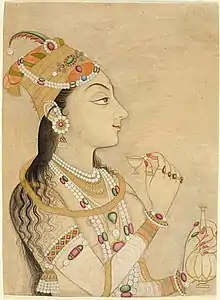Abrawan (āb-i-ravān) was a kind of muslin cloth produced in Indian subcontinent. The Abrawan was characterized by the nature of the fabric that was like flowing water.[1][2]
Name
Abrawan means ''running water'' that symbolizes its fineness.[3][4]
''Running water'' and ''Woven air'' were poetic names of contemporaneous muslins.[5]
Weave
Abrawan was a plain weave fabric made primarily of cotton, with silk variations available. It was a transparent, lightweight structure, one of Dacca's finest muslins.[1][2] Weavers used to weave qualities similar to Abrawan during the monsoon season to protect the yarn from breaking due to dry weather.[5]
Quotes
Abrawan was recorded for its fine texture. There are two stories related to Abrawan that demonstrate the grandeur of the fabric. The first one is related to an argument between the sixth Mughal emperor Aurangzeb and his daughter where the king is arguing modesty. Another tale is about the Nawab of Bengal Alivardi Khan expelling of a weaver who, ignored, let a cow swallow the Abrawan cloth overlaid on a lawn.[2]
The Hindoos amuse us with two stories, as instances of the fineness of this muslin. One, that the Emperor Aurungzebe was angry with his daughter for exposing her skin through her clothes; whereupon the young princess remonstrated in her justification that she had seven jamahs or suits on; and another, in the Nabob Allaverdy Khawn's time a weaver was chastised and turned out of the city for his neglect, in not preventing his cow from eating up a piece of abrooan, which he had spread and carelessly left on the grass.—Bolt[6][7]: 42
Present day uses
With time, the real artwork has inevitably lost all of its authentic characteristics. The imitation can be seen as
Tarbana
A form of Abrawan is Tarbana Sari. Tarbana is a silk and gold threaded tissue Sari. The fabric used in the production of Tarbanas contains a warp of silk and a weft of zari.[8][9][10]
See also
References
- 1 2 Balfour, Edward (1885). The Cyclopædia of India and of Eastern and Southern Asia, Commercial Industrial, and Scientific: Products of the Mineral, Vegetable, and Animal Kingdoms, Useful Arts and Manufactures. Bernard Quaritch. p. 830.
- 1 2 3 Cole, Henry Hardy; Tayler, William; Museum, South Kensington (1874). Catalogue of the Objects of Indian Art Exhibited in the South Kensington Museum. G. E. Eyre and W. Spottiswoode. p. 226.
- ↑ Fairchild's dictionary of textiles. Internet Archive. New York, Fairchild Publications. 1959. p. 4.
{{cite book}}: CS1 maint: others (link) - ↑ King, Brenda M. (2005-09-03). Silk and Empire. Manchester University Press. ISBN 978-0-7190-6700-6.
- 1 2 Weibel, Adèle Coulin (1952). Two thousand years of textiles; the figured textiles of Europe and the Near East. Internet Archive. New York, Published for the Detroit Institute of Arts [by] Pantheon Books. p. 54.
- ↑ Burnell, Henry Yule; Arthur. Hobson-Jobson.
{{cite book}}: CS1 maint: multiple names: authors list (link) - ↑ Chatterjee, Ramananda (1911). The Modern Review. Prabasi Press Private, Limited.
- ↑ Lynton, Linda (1995). The Sari: Styles, Patterns, History, Techniques. H.N. Abrams. pp. 56, 70. ISBN 978-0-8109-4461-9.
- ↑ Arts of Asia. Arts of Asia Publications. 1996. p. 8.
- ↑ King, Brenda M. (2005-09-03). Silk and Empire. Manchester University Press. pp. XVIII. ISBN 978-0-7190-6700-6.



.svg.png.webp)